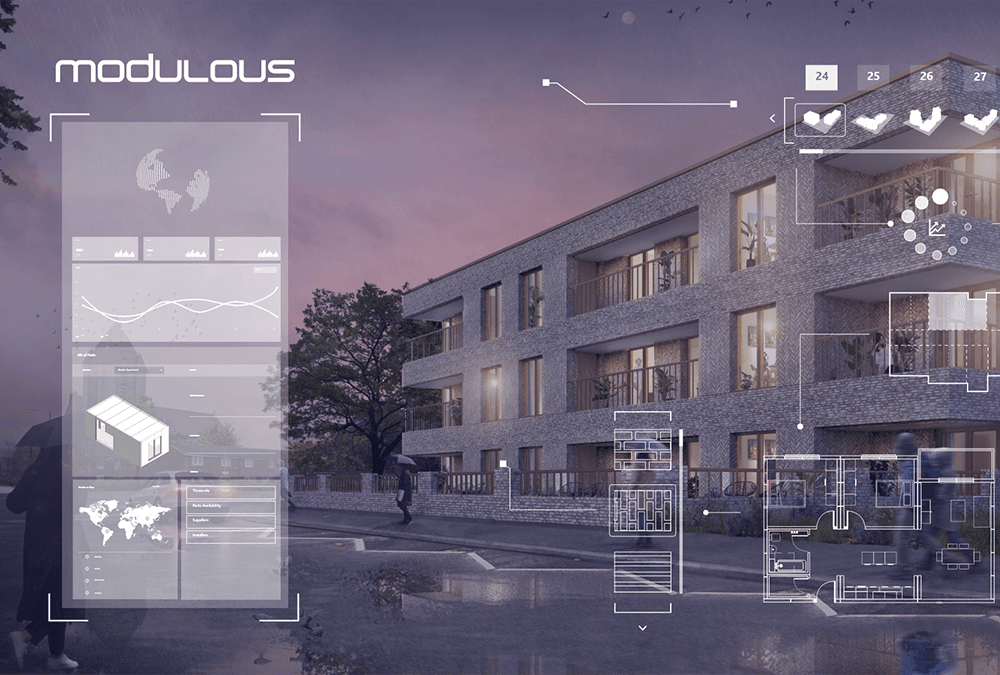We talked to Doug Jeffery, Principal Data Architect, to learn more about his team’s role at Modulous. Doug, what part does data play in Modern Methods of Construction—both now and in the future?
Well, if you think about MMC, or Modern Methods of Construction, it’s all about doing things better, faster, and more efficiently. And if you want all three at once, you’ve got to have data to enable it. As an example, let’s say that in the future you want to build 10,000 homes in the time that it currently takes to build 1,000. You can’t achieve that scale with current manual methods. But if you get data flowing, you can start to run processes that take people out of the equation and leverage the power of machines. You can get smart design and smart costing. So, we’re all about using data to increase pace and boost scale through automation and smart integration.
What kind of opportunities does data enable?
First you can see the impact in terms of the cost of your building. Then, instead of designing every building from the ground up, you have the benefits of smart design. That means having a library of modules or parts, and knowing all the information about those modules, what materials go in them, and how we can reduce the cost to build those modules. Suddenly you have clarity about how long it will take to build that building. Once you have these variables set — and this is particularly true if you want to do lots of these projects — you can see a fairly accurate estimate of how much money you’re going to make. That answers questions that are almost impossible to know now. And it keeps going. Further down the line, even more data starts to emerge that we can use. We can ask questions like, how do you manage waste, or how do you manage logistics?
How do you optimize the assembly and installation of modules?
I think it’s helpful to compare this to other forms of manufacturing. Say you wanted to build a car today. To understand that process, you have to analyse your supply chain. You have to automate your construction process. There’s all sorts of smart manufacturing and assembly that we can start to think about, and all those things let you reach that goal I mentioned — making something better, faster, and more efficient. You’ve got to be able to manage waste in a way that lets us hit our targets in terms of sustainability, carbon footprint, etc. But the data is the crucial part. It enables the automation and is the fuel that keeps the machine running.
How do you think data will shape Modulous’ relationships with real estate and construction stakeholders?
The software and the data assets we’re building will enable us to do things that other companies can’t. In the U.K., we’ve been working with town councils and housing associations. We talk to people who have enormous portfolios of land. It would take them years and it would cost them fortunes to even think about putting buildings on that land. With Modulous, you can start to imagine using your land assets to start doing feasibility studies on those pieces of land very quickly and cost-effectively. We can essentially speed up that project lifecycle.
Once we do that, it enables things we never really thought about before. Digitized planning extends to digitizing things like carbon targets or waste targets or other environmental benchmarks. When those things become reality, we can start to produce designs and assessments of both land and projects in entirely new ways that would otherwise be very expensive and very slow.
What role does this leave for architects and designers?
We have a phrase we use about trying to “automate the unseen.” To us that means eliminating all the difficult parts of designing and constructing a building, or if we can’t eliminate them, giving those parts over to computers. If we can automate those parts, then an architect or designer can focus on the things that are going to differentiate their building and integrate it into the neighbourhood – making it fit-for-purpose in that place.
I’ve heard from some architects who feel that this data- and automation-driven process might cut them out. But our view is that it enables them to automate the boring bits and focus on the creative bits. More than that, a process that brings a lot of certainty around the cost and the speed at which you can deliver something takes a whole load of risk out of the equation. And when you remove risk, it opens a whole lot of opportunities that don’t exist today for people at every stage of this process.
What is the impact on suppliers and manufacturers?
There are data opportunities in those areas, too. We’re starting to work with suppliers and manufacturers much more closely and we see two major impacts. The first is that we can start to use data to bring to life all the good stuff that they’re doing in terms of their material properties, and how that improves the quality, livability, and sustainability of the homes that we build. We can service those things and show that we bring a lot of pre-manufactured value, that we reduce waste, and that we’re reaching all these sustainability certifications. Once we start working at scale, the supply chain starts to look more like a retail supply chain. It comes down to reducing risk for these partners.
Tell us about the data group you’re building at Modulous and your vision for the team.
We’re building a small, focused team. Our priority is two-fold: first, to bring value to the business, and second, to iterate and evolve our technological platform. Great technology opens us to the art of the possible. But our first priority is to reduce friction in the rest of the business — to simplify the plumbing.
I also want to underscore that our work is not just about numbers and data sets. We want to work with people who are passionate about the human impact of our work. The question we should be asking is: What can we do with our data to not only improve our business, but to improve the jobs and lives of the people our work touches?



